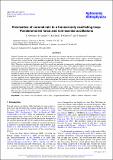Kinematics of coronal rain in a transversely oscillating loop : ponderomotive force and rain-excited oscillations
Abstract
Context. Coronal rain are cool dense blobs that form in solar coronal loops and are a manifestation of catastrophic cooling linked to thermal instability. Once formed, rain falls towards the solar surface at sub-ballistic speeds, which is not well-understood. Pressure forces seem to be the prime candidate to explain this. In many observations rain is accompanied by transverse oscillations and the interaction between the two needs to be explored. Aims. Therefore, an alternative kinematic model for coronal rain kinematics in transversely oscillating loops is developed to understand the physical nature of the observed sub-ballistic falling motion of rain. It explicitly explores the role of the ponderomotive force arising from the transverse oscillation on the rain motion as well as the capacity of rain to excite wave motion. Methods. An analytical model is presented that describes a rain blob guided by the coronal magnetic field supporting a one dimensional shear Alfvén wave as a point mass on an oscillating string. The model includes gravity and the ponderomotive force from the oscillation acting on the mass, as well as the inertia of the mass acting on the oscillation. Results. The kinematics of rain in the limit of negligible rain mass are explored and falling and trapped regimes are found, depending on wave amplitude. In the trapped regime for the fundamental mode, the rain blob bounces back and forth around the loop top at a long period inversely proportional to the oscillation amplitude. The model is compared with several observational rain studies, including one in-depth comparison with an observation that shows rain with up-and down bobbing motion. The role of rain inertia in exciting transverse oscillations is explored in inclined loops. Conclusions. It is found that the model requires displacement amplitudes of the transverse oscillation that are typically an order of magnitude larger than observed to explain the measured sub-ballistic motion of the rain. Therefore, it is concluded that the ponderomotive force is not the primary reason for understanding sub-ballistic motion, but it plays a role in cases of large loop oscillations.The appearance of rain causes the excitation of small-amplitude transverse oscillations that may explain observed events and provide a seismological tool to measure rain mass.
Citation
Verwichte , E , Antolin , P , Rowlands , G , Kohutova , P & Neukirch , T 2017 , ' Kinematics of coronal rain in a transversely oscillating loop : ponderomotive force and rain-excited oscillations ' , Astronomy & Astrophysics , vol. 598 , A57 . https://doi.org/10.1051/0004-6361/201629634
Publication
Astronomy & Astrophysics
Status
Peer reviewed
ISSN
0004-6361Type
Journal article
Description
E.V. acknowledges support from the Warwick STFC Consolidated Grant ST/L000733/I. P.A. acknowledges support from the EU Horizon 2020 Research and Innovation programme (grant agreement No. 647214). P.K. acknowledges support from a UK STFC PhD studentship. T.N. acknowledges support from the St Andrews STFC Consolidated Grant SN/N000609/1.Collections
Items in the St Andrews Research Repository are protected by copyright, with all rights reserved, unless otherwise indicated.

